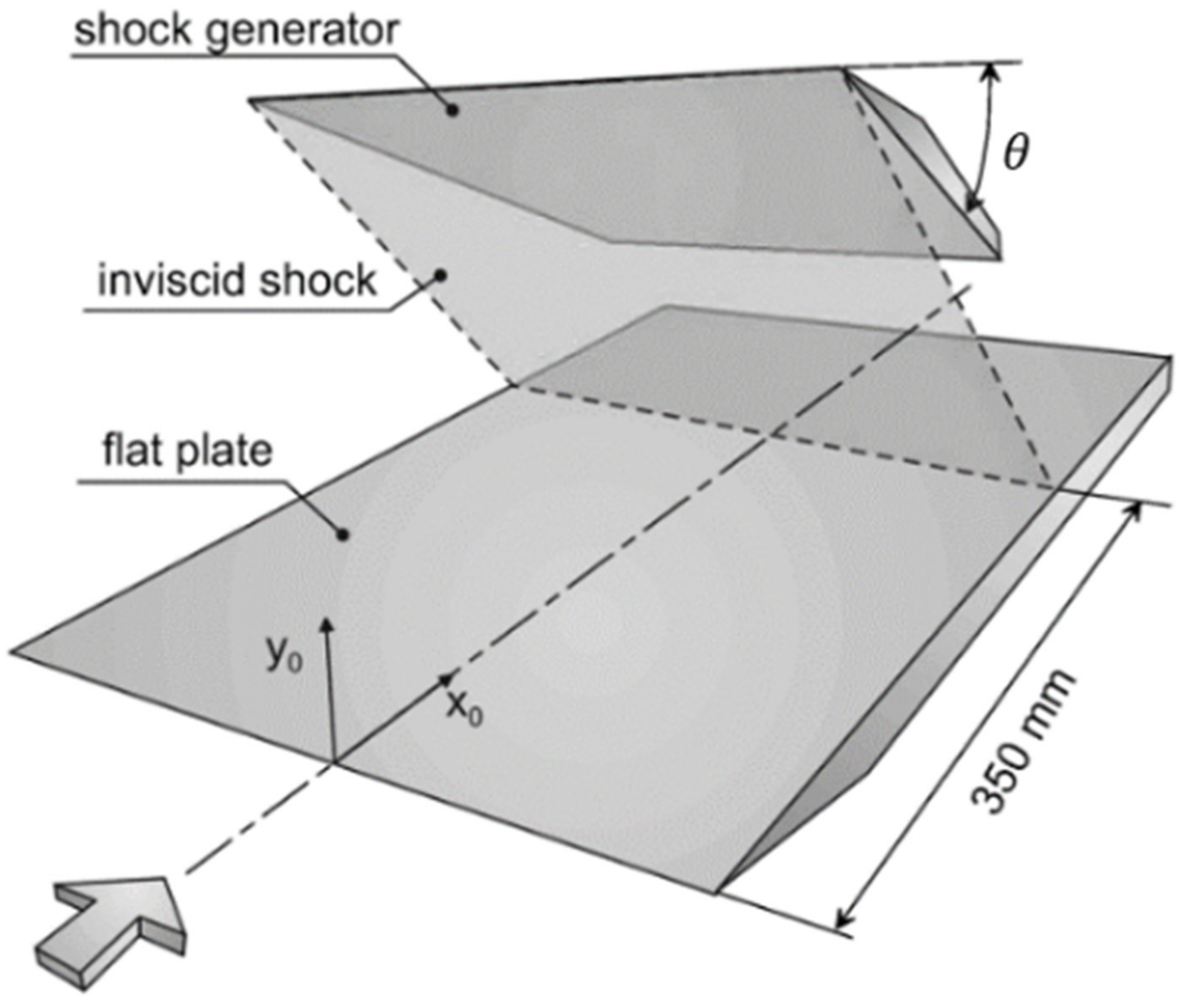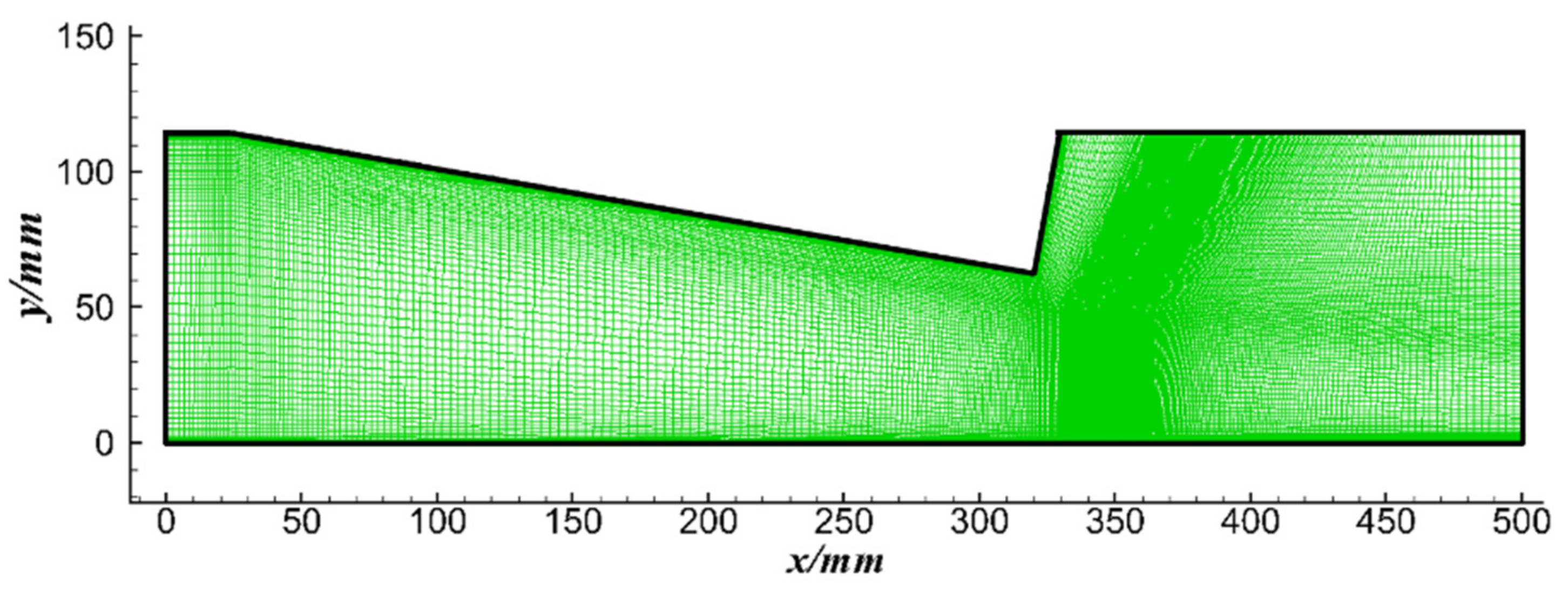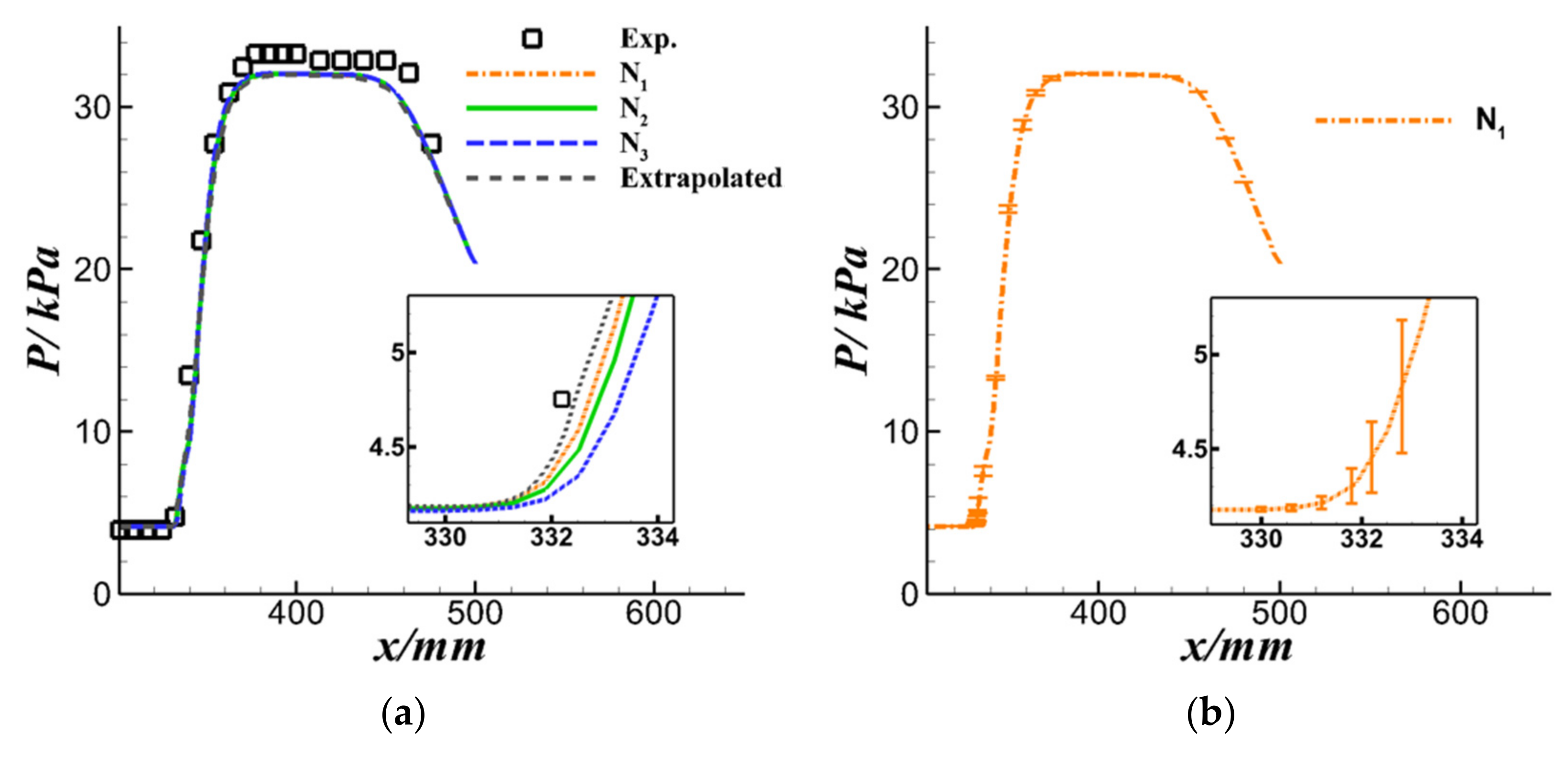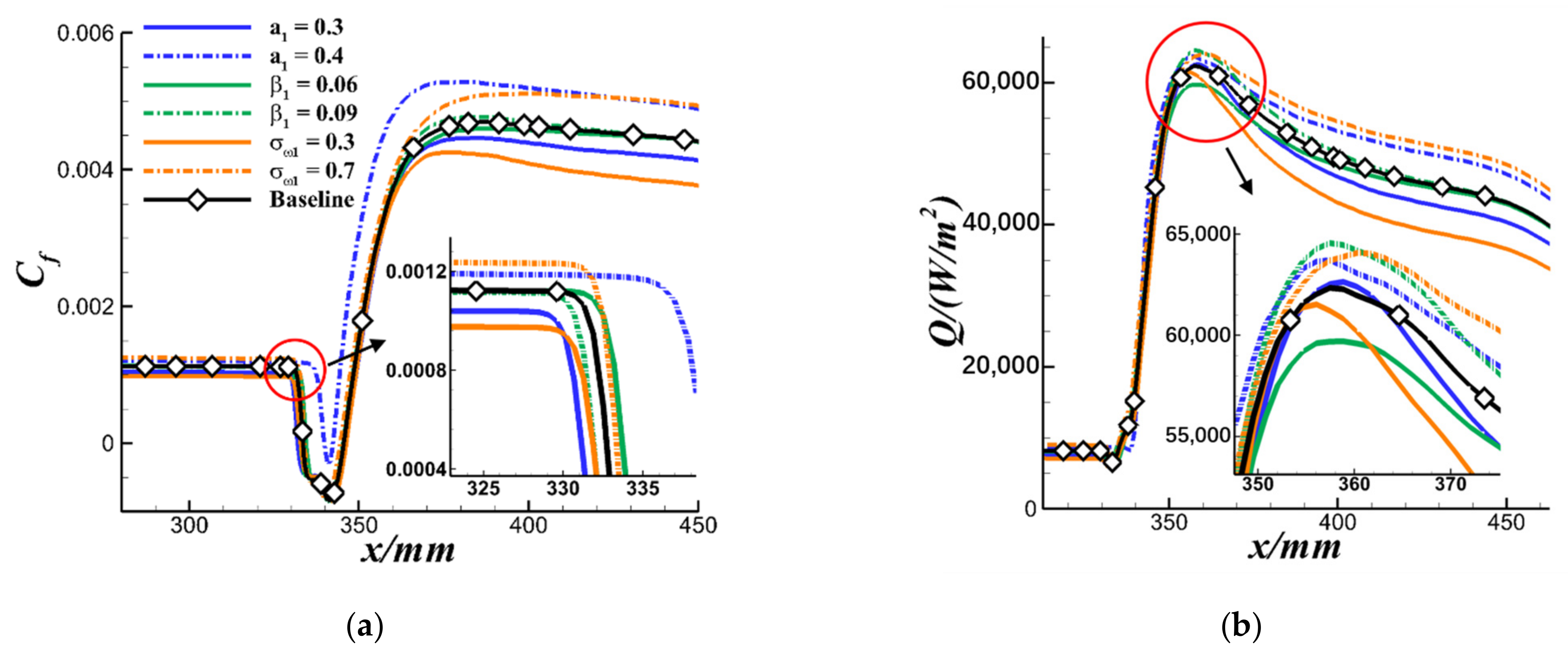Uncertainty Analysis of Parameters in SST Turbulence Model for Shock Wave-Boundary Layer Interaction
Abstract
:1. Introduction
2. Methods and Computational Details
2.1. SST Turbulence Model
2.2. Uncertainty Analysis
2.2.1. Uncertainty Quantification
2.2.2. Sensitivity Analysis
2.3. Computational Details
2.3.1. Flow Cases
2.3.2. Grid Independence Analysis
3. Results and Discussion
3.1. Baseline Results
3.2. Uncertainty Quantification
3.3. Sensitivity Analysis
4. Conclusions
- The flow mechanism of SWBLIs was highly intricate. Although the SST turbulence model could simulate the basic interaction process and accurately predict the position of the separation point, there were obvious deviations between the prediction results and the experimental data for the skin friction and wall heat flux after reattachment.
- The uncertainty of the model parameters had a significant influence on the prediction results. For the spatial flow field, the uncertainty of the model parameters generated significant uncertainty in the prediction of the Mach number in the separation region and the prediction of pressure at the shock waves caused by separation. For those wall properties, although the parameters’ uncertainties had little effect on the prediction of the wall pressure, the uncertainties of the skin friction and wall heat flux in the boundary layer after reattachment were nearly 30%. Moreover, the influence of the parameters’ uncertainty was intensified with an increase in incident shock wave intensity for most of QoIs. Therefore, the parameters’ uncertainties should be considered in engineering to increase the reliability and completeness of the RANS results.
- Through sensitivity analysis, based on the results of the parameters’ Sobol index for different QoIs, the key parameters that contributed most to the uncertainties generated in QoIs were , , and . Furthermore, by changing those model parameters separately, their effects on the prediction of the average flow were investigated. Among them, parameter had the most crucial influence on the prediction of the separation point; parameter mainly influenced the skin friction and wall heat flux after reattachment; and parameter was responsible for the uncertainties in the peak of heat flux. The identification and further study of key parameters can deepen the cognition of the model parameters and provide a reference for engineering applications as well as potential guidance for the model’s future improvement.
Author Contributions
Funding
Data Availability Statement
Acknowledgments
Conflicts of Interest
Abbreviations
| CFD | Computational Fluid Dynamics |
| DNS | Direct Numerical Simulation |
| LES | Large Eddy Simulation |
| LUSGS | Lower-Upper Symmetric Gauss-Seidel |
| MUSCL | Monotone Upstream-centered Schemes for Conservation Laws |
| NIPC | Non-Intrusive Polynomial Chaos |
| QoIs | Quantities of interests |
| RANS | Reynolds Averaged Navier-Stokes |
| SA | Spalart-Allmaras |
| SST | Shear-Stress Transport |
| SWBLIs | Shock wave-boundary layer interactions |
| UQ | Uncertainty Quantification |
| Nomenclature | |
| turbulent Prandtl number | |
| turbulence kinetic energy | |
| dissipation per unit turbulence kinetic energy | |
| turbulent eddy dissipation | |
| density | |
| velocity | |
| molecular viscosity | |
| turbulent eddy viscosity | |
| production term of equation | |
| Reynold shear stress | |
| strain rate tensor | |
| vorticity magnitude | |
| blending functions in SST model | |
| the parameter in the calculation of in SST model | |
| Von Kármán’s constant | |
| parameter in the dissipation term of equation | |
| parameter in the dissipation term of equation | |
| parameter in the diffusion term of equation | |
| parameter in the diffusion term of equation | |
| the scaling coefficient between the production terms of and equations | |
| parameters from the original model | |
| parameters from the transformed model | |
| the shortest distance to the wall | |
| system output | |
| system input/random variable | |
| polynomial chaos expansion coefficients | |
| orthogonal polynomial | |
| number of expanded terms | |
| order of polynomial chaos expansion | |
| inputs number of polynomial chaos expansion | |
| oversampling ratio | |
| number of training samples | |
| mean value, variance, and standard deviation of QoIs | |
| upper and lower boundary of QoIs’ uncertainty interval | |
| Sobol index | |
| angle of the shock generator | |
| freestream Mach number | |
| freestream Reynold number | |
| wall temperature | |
| wall pressure | |
| skin friction | |
| wall heat flux | |
| grid resolution | |
| grid refinement factor | |
| the simulation result for grid | |
| observed order of accuracy | |
| extrapolated value | |
| approximate relative error | |
| extrapolated relative error | |
| grid convergence index | |
References
- Chung, K.-M.; Huang, Y.-X. Global Visualization of Compressible Swept Convex-Corner Flow Using Pressure-Sensitive Paint. Aerospace 2021, 8, 106. [Google Scholar] [CrossRef]
- Chung, K.-M.; Su, K.-C.; Chang, K.-C. The Effect of Vortex Generators on Shock-Induced Boundary Layer Separation in a Transonic Convex-Corner Flow. Aerospace 2021, 8, 157. [Google Scholar] [CrossRef]
- Semlitsch, B.; Mihăescu, M. Fluidic Injection Scenarios for Shock Pattern Manipulation in Exhausts. AIAA J. 2018, 56, 4640–4644. [Google Scholar] [CrossRef]
- Semlitsch, B.; Mihăescu, M. Evaluation of Injection Strategies in Supersonic Nozzle Flow. Aerospace 2021, 8, 369. [Google Scholar] [CrossRef]
- Running, C.L.; Juliano, T.J. Global Skewness and Coherence for Hypersonic Shock-Wave/Boundary-Layer Interactions with Pressure-Sensitive Paint. Aerospace 2021, 8, 123. [Google Scholar] [CrossRef]
- Schülein, E.; Krogmann, P.; Stanewsky, E. Documentation of Two-Dimensional Impinging Shock/Turbulent Boundary Layer interaction Flow; Institute of Aerodynamics and Flow Technology: Göttingen, Germany, 1996; pp. 1–65. [Google Scholar]
- Fedorova, N.N.; Fedorchenko, I.A.; Schülein, E. Experimental and Numerical Investigation of the Oblique Shock Wave/Turbulent Boundary Layer Interaction at M=5. J. Appl. Math. Mech. 2001, 81, 773–774. [Google Scholar] [CrossRef]
- Schülein, E. Skin Friction and Heat Flux Measurements in Shock/Boundary Layer Interaction Flows. AIAA J. 2006, 44, 1732–1741. [Google Scholar] [CrossRef]
- Duraisamy, K.; Spalart, P.R.; Rumsey, C.L. Status, Emerging Ideas and Future Directions of Turbulence Modeling Research in Aeronautics; Technical Memorandum NASA/TM–2017–219682; NASA: Hampton, VA, USA, 2017. [Google Scholar]
- Thivet, F.; Knight, D.D.; Zheltovodov, A.A.; Maksimov, A.I. Insights in Turbulence Modeling for Crossing-Shock-Wave/Boundary-Layer Interactions. AIAA J. 2001, 39, 985–995. [Google Scholar] [CrossRef]
- Steelant, J. Effect of a compressibility correction on different turbulence models. Eng. Turbul. Modell. Exp. 2002, 5, 207–216. [Google Scholar]
- Morkovin, M.V. Effects of Compressibility on Turbulent Flows; de la Turbulence, M., Favre, A., Eds.; Gordon and Breach: New York, NY, USA, 1964. [Google Scholar]
- Xiao, X.; Hassan, H.A.; Edwards, J.R.; Gaffney, R.L. Role of Turbulent Prandtl Numbers on Heat Flux at Hypersonic Mach Numbers. AIAA J. 2007, 45, 806–813. [Google Scholar] [CrossRef]
- Roy, S.; Pathak, U.; Sinha, K. Variable Turbulent Prandtl Number Model for Shock/Boundary-Layer Interaction. AIAA J. 2018, 56, 342–355. [Google Scholar] [CrossRef]
- Lillard, R.P.; Oliver, B.; Olsen, M.; Blaisdell, G.; Lyrintzis, A. The lagRST Model: A Turbulence Model for Non-Equilibrium Flows. In Proceedings of the 50th AIAA Aerospace Sciences Meeting including the New Horizons Forum and Aerospace Exposition, Nashville, TN, USA, 9–12 January 2012. [Google Scholar]
- Slotnick, J.; Khodadoust, A.; Alonso, J.; Darmofal, D.; Gropp, W.; Lurie, E.; Mavriplis, D. CFD Vision 2030 Study: A Path to Revolutionary Computational Aerosciences; Technical Publication NASA/CR-2014-218178; NASA: Hampton, VA, USA, 2014. [Google Scholar]
- Durbin, P.A. Some Recent Developments in Turbulence Closure Modeling. Annu. Rev. Fluid Mech. 2018, 50, 77–103. [Google Scholar] [CrossRef]
- Xiao, H.; Cinnella, P. Quantification of model uncertainty in RANS simulations: A review. Prog. Aerosp. Sci. 2019, 108, 1–31. [Google Scholar] [CrossRef] [Green Version]
- Menter, F.R. Two-equation eddy-viscosity turbulence models for engineering applications. AIAA J. 1994, 32, 1598–1605. [Google Scholar] [CrossRef] [Green Version]
- Matyushenko, A.A.; Garbaruk, A.V. Adjustment of the k-ω SST turbulence model for prediction of airfoil characteristics near stall. In Proceedings of the 18th International Conference PhysicA.SPb , Saint-Petersburg, Russia, 26–29 October 2015. [Google Scholar]
- Hu, Y. Research on the Effects of Numerical Simulation Parameters of Separation Vortex Flow Field. J. Mech. Eng. 2016, 52, 165–172. [Google Scholar] [CrossRef]
- Schaefer, J.; Hosder, S.; West, T.; Rumsey, C.; Carlson, J.-R.; Kleb, W. Uncertainty Quantification of Turbulence Model Closure Coefficients for Transonic Wall-Bounded Flows. AIAA J. 2017, 55, 195–213. [Google Scholar] [CrossRef]
- Erb, A.J.; Hosder, S. Uncertainty Analysis of Turbulence Model Closure Coefficients for Shock Wave-Boundary Layer Interaction Simulations. In Proceedings of the 2018 AIAA Aerospace Sciences Meeting, Kissimmee, FL, USA, 8–12 January 2018. [Google Scholar]
- Di Stefano, M.A.; Hosder, S.; Baurle, R.A. Effect of Turbulence Model Uncertainty on Scramjet Isolator Flowfield Analysis. J. Propul. Power 2020, 36, 109–122. [Google Scholar] [CrossRef]
- Zhao, Y.; Yan, C.; Wang, X.; Liu, H.; Zhang, W. Uncertainty and sensitivity analysis of SST turbulence model on hypersonic flow heat transfer. Int. J. Heat Mass Transfer. 2019, 136, 808–820. [Google Scholar] [CrossRef]
- Subbian, G.; Botelho e Souza, A.C.; Radespiel, R.; Zander, E.; Friedman, N.; Moshagen, T.; Moioli, M.; Breitsamter, C.; Sørensen, K.A. Calibration of an extended Eddy Viscosity Turbulence Model using Uncertainty Quantification. In Proceedings of the AIAA Scitech 2020 Forum, Orlando, FL, USA, 6–10 January 2020. [Google Scholar]
- Li, J.; Chen, S.; Cai, F.; Wang, S.; Yan, C. Bayesian uncertainty analysis of SA turbulence model for supersonic jet interaction simulations. Chin. J. Aeronaut. 2021, 35, 185–201. [Google Scholar] [CrossRef]
- Han, D.; Hosder, S. Inherent and Model-Form Uncertainty Analysis for CFD Simulation of Synthetic Jet Actuators. In Proceedings of the 50th AIAA Aerospace Sciences Meeting including the New Horizons Forum and Aerospace Exposition, Nashville, TN, USA, 9–12 January 2012. [Google Scholar]
- Eldred, M.; Webster, C.; Constantine, P. Evaluation of Non-Intrusive Approaches for Wiener-Askey Generalized Polynomial Chaos. In Proceedings of the 49th AIAA/ASME/ASCE/AHS/ASC Structures, Structural Dynamics, and Materials Conference, Schaumburg, IL, USA, 7–10 April 2008. [Google Scholar]
- Liu, H.; Yan, C.; Zhao, Y.; Qin, Y. Uncertainty and sensitivity analysis of flow parameters on aerodynamics of a hypersonic inlet. Acta Astronaut. 2018, 151, 703–716. [Google Scholar] [CrossRef]
- McKay, M.D.; Beckman, R.J.; Conover, W.J. Comparison of Three Methods for Selecting Values of Input Variables in the Analysis of Output from a Computer Code. Technometrics 1979, 21, 239–245. [Google Scholar]
- Hosder, S.; Walters, R.; Balch, M. Efficient Sampling for Non-Intrusive Polynomial Chaos Applications with Multiple Uncertain Input Variables. In Proceedings of the 48th AIAA/ASME/ASCE/AHS/ASC Structures, Structural Dynamics, and Materials Conference, Honolulu, HI, USA, 23–26 April 2007. [Google Scholar]
- Crestaux, T.; Le Maıtre, O.; Martinez, J.-M. Polynomial chaos expansion for sensitivity analysis. Reliab. Eng. Syst. Saf. 2009, 94, 1161–1172. [Google Scholar] [CrossRef]
- Zhou, L.; Zhao, R.; Yuan, W. An investigation of interface conditions inherent in detached-eddy simulation methods. Aerosp. Sci. Technol. 2018, 74, 46–55. [Google Scholar] [CrossRef]
- Celik, I.B.; Ghia, U.; Roache, P.J.; Freitas, C.J.; Coleman, H.; Raad, P.E. Procedure for Estimation and Reporting of Uncertainty Due to Discretization in CFD Applications. J. Fluids Eng. 2008, 130, 07800101–07800104. [Google Scholar]
- Brown, J.L. Shock Wave Impingement on Boundary Layers at Hypersonic Speeds: Computational Analysis and Uncertainty. In Proceedings of the 42nd AIAA Thermophysics Conference, Honolulu, HI, USA, 27–30 June 2011. [Google Scholar]
















| Parameter | Standard Value | Lower | Upper |
|---|---|---|---|
| 0.5 | 0.3 | 0.7 | |
| 0.856 | 0.7 | 1.0 | |
| 0.85 | 0.7 | 1.0 | |
| 1.0 | 0.8 | 1.2 | |
| 0.075 | 0.06 | 0.09 | |
| 0.0828 | 0.07 | 0.1 | |
| 0.09 | 0.0784 | 0.1024 | |
| 0.31 | 0.30 | 0.40 | |
| 0.41 | 0.38 | 0.42 |
| 577 × 211 | 385 × 141 | 257 × 94 | 1.5 | 5.410 | 5.254 | 4.918 | |
| 1.89 | 5.545 | 2.43% | 7.20% | 11.30% | 17.08% |
| Experiment | SST Turbulence Model | ||
|---|---|---|---|
| Boundary layer thickness at x = 296 mm | 4.10 mm | 4.08 mm | |
| θ = 10° | Separation position | 334.0 mm | 333.5 mm |
| Reattachment position | 345.0 mm | 345.4 mm | |
| θ = 14° | Separation position | 314.0 mm | 313.2 mm |
| Reattachment position | 347.0 mm | 345.7 mm | |
| Separation Position | Reattachment Position | The Position of | |||||
|---|---|---|---|---|---|---|---|
| θ = 10° | 1.08% | 23.24% | 23.13% | 2.4% | 1.0% | 11.64% | 1.58% |
| θ = 14° | 1.83% | 29.52% | 32.67% | 3.32% | 0.85% | 17.55% | 1.31% |
Publisher’s Note: MDPI stays neutral with regard to jurisdictional claims in published maps and institutional affiliations. |
© 2022 by the authors. Licensee MDPI, Basel, Switzerland. This article is an open access article distributed under the terms and conditions of the Creative Commons Attribution (CC BY) license (https://creativecommons.org/licenses/by/4.0/).
Share and Cite
Zhang, K.; Li, J.; Zeng, F.; Wang, Q.; Yan, C. Uncertainty Analysis of Parameters in SST Turbulence Model for Shock Wave-Boundary Layer Interaction. Aerospace 2022, 9, 55. https://doi.org/10.3390/aerospace9020055
Zhang K, Li J, Zeng F, Wang Q, Yan C. Uncertainty Analysis of Parameters in SST Turbulence Model for Shock Wave-Boundary Layer Interaction. Aerospace. 2022; 9(2):55. https://doi.org/10.3390/aerospace9020055
Chicago/Turabian StyleZhang, Kailing, Jinping Li, Fanzhi Zeng, Qiang Wang, and Chao Yan. 2022. "Uncertainty Analysis of Parameters in SST Turbulence Model for Shock Wave-Boundary Layer Interaction" Aerospace 9, no. 2: 55. https://doi.org/10.3390/aerospace9020055






